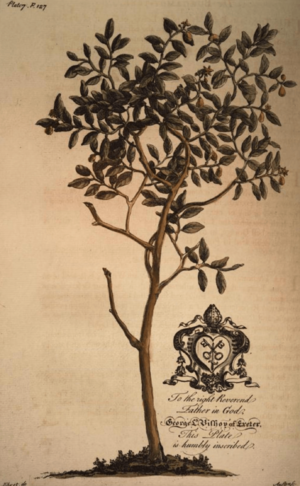Forbidden fruit (citrus) facts for kids
The forbidden fruit (also called shaddette) is a special kind of citrus fruit. It originally comes from the island of Saint Lucia. For a long time, people believed it was the plant that the grapefruit first came from.
A Look Back in Time
The first known description of the forbidden fruit was written in 1750. It was in a book by Griffith Hughes called The Natural History of Barbados.
Hughes said the 'Forbidden-fruit-tree' looked like an orange tree. Its fruit was bigger and longer than an orange. He wrote that it tasted a bit like a shaddock. But he also said it was much more delicious than any other fruit on that island or nearby islands.
Hughes drew a picture of the tree. However, he wasn't a plant expert. So, some details in his description might not be perfectly accurate.
The fruit wasn't just in Barbados. In 1756, it was also found in Jamaica. People there said it was "excell[ing] in sweetness," meaning it was very sweet.
In the Caribbean, people tried to grow shaddock trees from seeds. This was often hard to do and didn't always produce pure shaddock fruit. Because of this, experts think the forbidden fruit grew from a natural mix. It likely came from a seed of a pomelo and a sweet orange. Both of these fruits were known to be in Barbados by 1687.
Later, in the 1900s, scientists thought it might be a type of pomelo or grapefruit. Grapefruit is also a mix of orange and shaddock. But the forbidden fruit wasn't studied much. People thought it had disappeared forever.
Finding It Again
In the 1990s, people on Saint Lucia were asked about local plants. They pointed out two plants they called the forbidden fruit. One was a type of shaddock. The other one matched the old descriptions of the forbidden fruit more closely.
This rediscovered forbidden fruit is a natural mix. It has a special quality called high monoembryony. This means its seeds often produce only one plant. This quality makes it very important for growing new types of sweet oranges, grapefruits, and special plants used as rootstock. It helps create stronger and better fruit trees.


